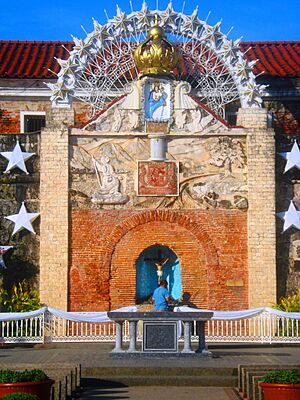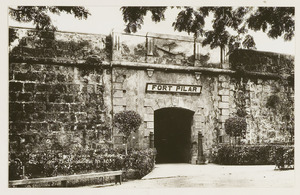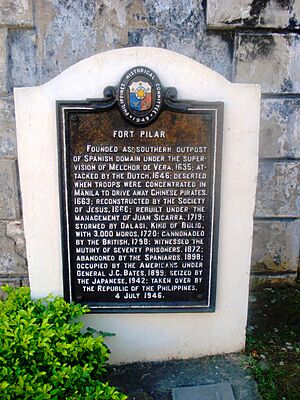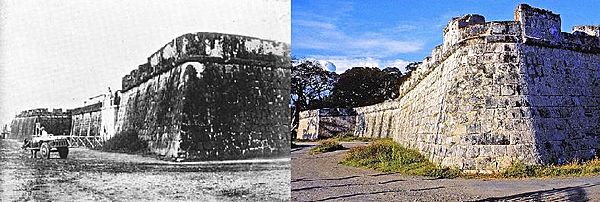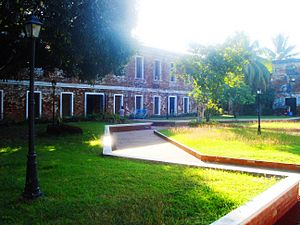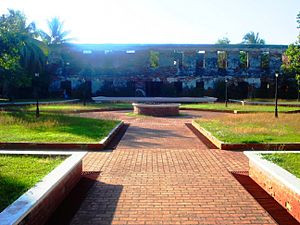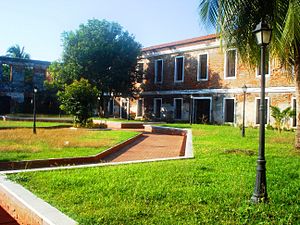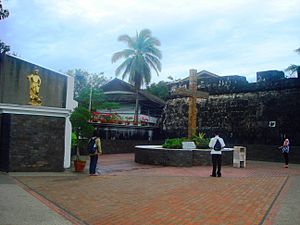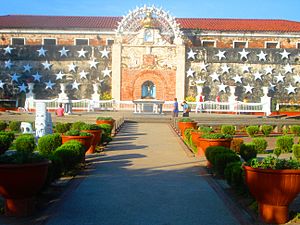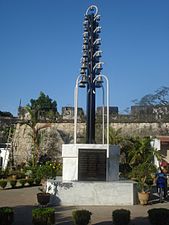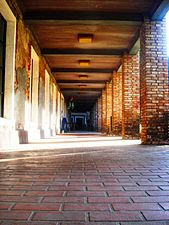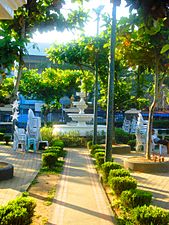Fort Pilar facts for kids
Quick facts for kids Fort Pilar |
|
|---|---|
|
Real Fuerte de Nuestra Señora del Pilar de Zaragoza
|
|
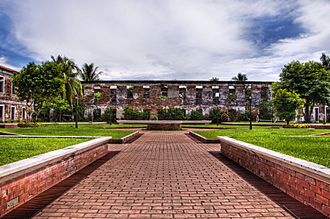
The Courtyard of Fort Pilar
|
|
| Former names | Real Fuerte de San José (Royal Fort of Saint Joseph) |
| Alternative names | Fortaleza del Pilar |
| General information | |
| Type | Fortification |
| Architectural style | Bastioned fort |
| Address | N.S. Valderosa Street |
| Town or city | Zamboanga City |
| Country | Philippines |
| Coordinates | 6°54′4″N 122°4′56″E / 6.90111°N 122.08222°E |
| Current tenants | National Museum of the Philippines |
| Groundbreaking | June 23, 1635 |
| Owner | Philippine Government |
| Technical details | |
| Structural system | Masonry |
| Design and construction | |
| Architect | Father Melchor de Vera (1635) Juan Sicarra (1718) |
Fort Pilar, also known by its longer Spanish name Real Fuerte de Nuestra Señora del Pilar de Zaragoza, is a very old military fort in Zamboanga City, Philippines. It was built by the Spanish government way back in the 1600s.
Today, Fort Pilar is a special museum managed by the National Museum of the Philippines. It's a famous spot in Zamboanga City and shows off a lot of the city's history and culture.
Right outside the fort's eastern wall, there's a shrine dedicated to Our Lady of the Pillar. She is considered the special protector of the city.
Contents
History of Fort Pilar
Building the Fort
In 1635, some Jesuit missionaries and a bishop asked the Spanish governor, Juan Cerezo de Salamanca, for help. They wanted a strong stone fort to protect against pirates and raiders from nearby islands.
So, on June 23, 1635, they started building the fort. It was first called Real Fuerte de San José, meaning "Royal Fort of Saint Joseph." A Jesuit priest and engineer named Melchor de Vera laid the first stone. This date is also when Zamboanga City was officially founded!
Building the fort needed many workers. People from different parts of the Philippines, like Cavite and Cebu, helped the Spanish, Mexican, and Peruvian builders. During this time, a new language called Zamboangueño Chavacano started to form. It was a mix of Spanish and local languages.
Early Battles and Changes
Fort San José faced its first big challenge in 1646 when the Dutch attacked it. Later, in 1662, the Spanish soldiers left the fort to help fight a Chinese pirate named Koxinga in Manila.
After the soldiers left, pirates damaged the fort. But in 1669, the Jesuit missionaries came back and rebuilt it.
In 1718–1719, the fort was rebuilt again by an engineer named Juan Sicarra. This time, it was given a new name: Real Fuerte de Nuestra Señora del Pilar de Zaragoza. This new name honored Our Lady of the Pillar, who is a patron saint of Spain.
Just a year later, a king named Dalasi and 3,000 Moro pirates attacked the fort. But the brave defenders managed to fight them off. In 1798, even the British Royal Navy tried to attack the fort, but it was too strong and they couldn't take it.
Stories of Miracles
In 1734, a special carving of Our Lady of the Pillar was placed on the eastern wall of the fort. This turned that part of the fort into an outdoor shrine with an altar.
There's a famous story that on December 6, 1734, the Virgin Mary appeared to a soldier at the city gate. The soldier was amazed and knelt down when he recognized her.
Another story says that during a time when Dutch ships were attacking the fort, the Virgin Mary appeared to a Spanish soldier. She promised him victory if the soldiers kept fighting. The shrine was built to remember this event.
On September 21, 1897, a very strong earthquake hit Mindanao. People said they saw the Virgin Mary floating in the air over the Basilan Strait. She raised her hand, and the huge waves that were coming towards the city stopped, saving everyone from a tsunami.
Years later, when another big earthquake caused a tsunami in 1976, people again reported seeing Mary over the sea, protecting them from the disaster.
Changes in Control
After the Spanish–American War, the Spanish soldiers at Fort Pilar gave up control to the Republic of Zamboanga on May 18, 1899. This happened during the Philippine Revolution against Spain.
Later, on November 19, 1899, American forces took control of the fort.
Fort Pilar in World War II
During World War II in 1942, Japanese forces captured Fort Pilar. But in March 1945, American and Filipino soldiers fought back and recaptured it.
Finally, on July 4, 1946, the fort was officially given to the government of the newly independent Republic of the Philippines.
Bringing the Fort Back to Life
Fort Pilar was recognized as a National Cultural Treasure in 1973. However, it had been damaged during World War II and needed repairs.
The National Museum of the Philippines started restoring the fort in the early 1980s. They rebuilt three of the four main buildings inside. After six years of hard work, a museum opened to the public with an exhibit on Philippine art.
In 1987, a permanent exhibit about the amazing marine life of the Zamboanga Peninsula, Basilan, and Sulu opened. It showed over 400 different kinds of sea creatures in large displays. Another exhibit displayed items from an 18th-century Shipwreck called the Griffin.
Many people helped make the Fort Pilar Museum what it is today, including former Zamboanga City Mayor Maria Clara Lobregat.
Fort Pilar Today
Today, Fort Pilar is both a special outdoor Roman Catholic shrine and a regional museum. Inside the fort, one of the old buildings is still in ruins, but the rest of the fort and its gardens are well cared for.
The Paseo del Mar is a walkway built along the coast. It helps protect the fort from the sea and is a nice place for people to walk.
Parts of the Fort
See also
 In Spanish: Fuerte del Pilar para niños
In Spanish: Fuerte del Pilar para niños



